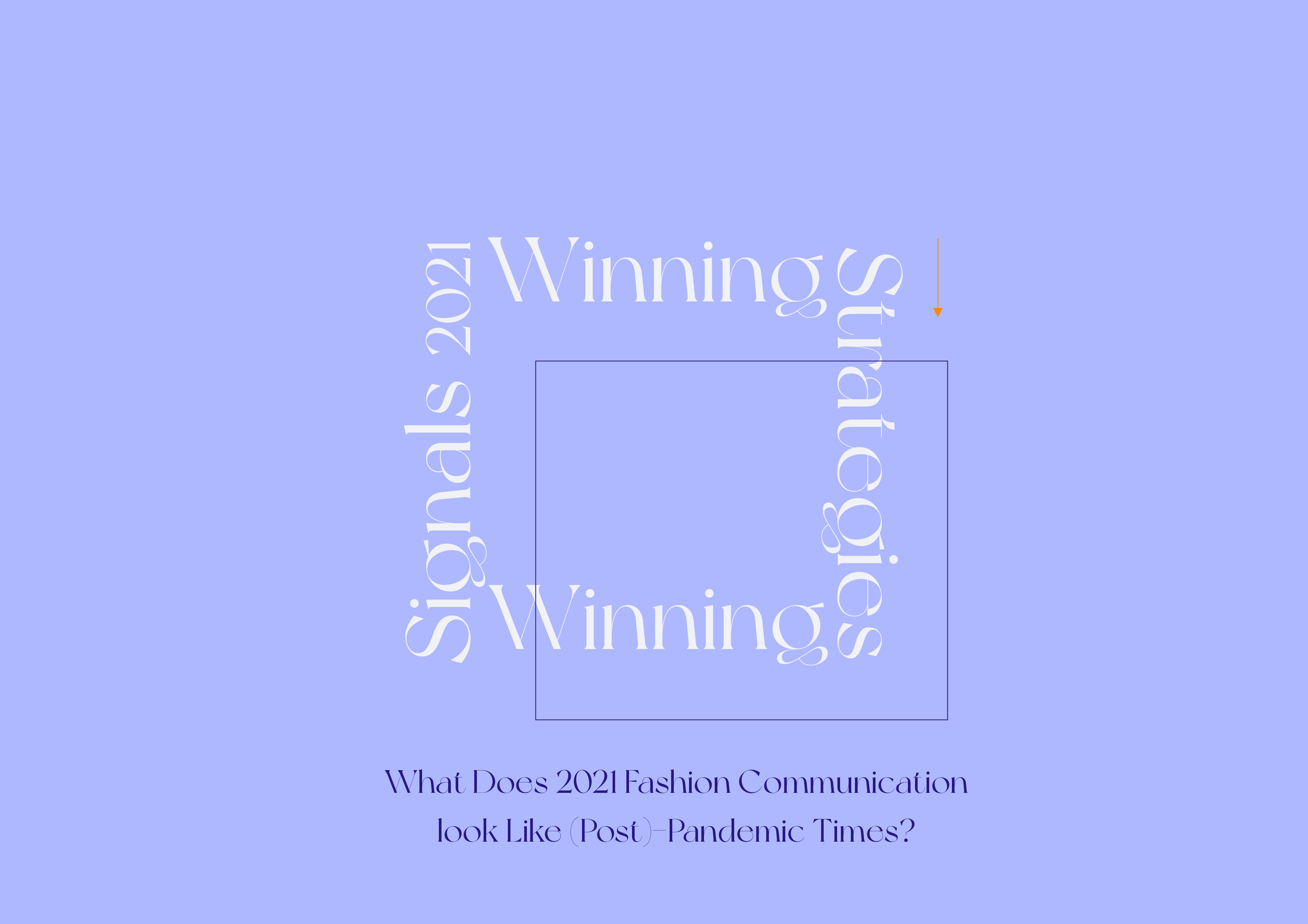Trend Forecast on Fashion Communication in 2021

Introduction
2020 goes undoubtedly into the books as one of the years that turned the fashion industry – and the whole world – upside-down. Fashion events were cancelled, the economy was in crisis, and the supply chains were disrupted. Consumer behaviours shifted at a surprising speed, accelerating trends evolving before the pandemic, as shopping shifting to digital and consumer expecting fairness and social justice. In short, the fashion industry had to re-evaluate its whole system and rethink its general purpose. Uncertainty was indeed a word that defined the state of fashion in 2020, demanding from brands and individuals to show flexibility and agility and demonstrate resilience to manage change.
Fashion brands and their communication strategies had to adapt fast to the changing consumer behaviours, adapting to a language that shifted suddenly to the digital world. Social media replaced mass media, remote working replaced office-bound jobs and e-commerce and online shopping replaced brick and mortar retail. Brands needed to find their Silver Lining in the new circumstances they are in. The pandemic has offered many opportunities – as a chance to reset, a levelling of the playing field, a moment to refocus and fine-tune our priorities (Hooper, 2021). So, where is fashion communication in 2021?
The digital sphere has become the chosen source of messaging during the pandemic, having brands communicate on various channels, competing for relevance at an even broader market. Innovation and originality have become vital to draw attention to the brand and stand out on the media flooded social platform. Although it seems that the digital is taking over, brands also need to prepare for the world after the pandemic when life returns to normal – or at least a "new normal". Indeed, the fashion industry will not turn back to what it was once before.
“In 2021, content will be key and amplification will be more crucial than ever before. In the end, brand performance will be linked to how brands merge the two formats, to create impactful, share-worthy moments both on- and offline. Moving forward, it’s important that brands consider how they will package and distribute their digital assets, to provide the media, influencers as well as other ‘Voices’ with the right content to reach the right consumer, at the right time.”
Especially in a time of uncertainty, irrelevant or banal messaging will generate the failure of communication. Finding the right communication strategy for a target audience requires a thorough analysis of consumer insights. Consumer insight is the analysis of human behaviour, needs and trends to understand the target audience and create a communication strategy that is effective and relevant. This will give brands the chance to fully understand their target and reach them with the right signs and signals that they need at that time. The consumers – their feelings, desires, and needs - should be at the centre of the brand, not the product.
Mapping consumer emotions provides an advantage for creating an effective and relevant communication strategy. Due to the pandemic, people were hit with "multiple emotional states, from boredom to fear, anticipation and resentment" (Rocca, 2021: on line). The pandemic rollercoaster has created an emotional plurality that has simultaneously forced people to accept and cope with multiple emotional states. Tracking these emotions enables us to understand the immediate reactions and the behavioural trajectories that will continue in 2021. Empathy will be essential to resonate with customers' emotional states and align the communication strategy and the products and services.
It is worth noting that changes in the fashion industry are often led by consumer demands. Especially over the last decades, the fashion industry has been in catch-up mode, trying to keep up with the changing consumer behaviours and the fast speed of new trends, ideas, and technological advancements. The pandemic has shown that brands must focus even more on future-proofing their brand, including investing big in digital and ensuring responsibility, sustainability, and accountability. In addition, consumers are more interested than ever in the values, mission and vision of a brand and want to connect with people that resonate with their emotions.
This report will analyse three winning brand messaging and signals that are contradictory as they coincide, exploring how brands are including those themes into their fashion communication through new mediums, developments, and trends. Furthermore, it will give some critical ideas on where fashion communication is heading (post)-pandemic and some suggestions on how brands can adapt.

Brand Strategies in 2021
There has always been an element of paradox regarding consumer behaviours—a juxtaposition of different values that, in hindsight, seem to make sense. Particularly in times of the pandemic and how differently it affects people, capturing the sentiments and emotions of generations has become even more complex than before. Brands must be cautious and respectful with their messaging, signals, and communication.
So, what are the key themes that seem to define the consumer sentiments now? Connection, Digitalization and Nostalgia. Themes that are so different in their messaging; however, they create the perfect balance. Now someone could say that these themes are so banal and obvious, hence not even worth mentioning. I do not deny that the selection of themes is somewhat apparent - social distancing has robbed us of any possibility of human connection and touch, while lockdowns have forced us to turn to the digital world to escape reality, resulting in solitude that makes us dream about the past and times where physical was still an option. Nonetheless, those themes are the key drivers of fashion communication in 2021 as they evolve around emotions generations feel at this point in time.
For brands, it is essential to find their position and communication strategy in the emotional sea that the pandemic has caused. Identifying their core target and customers' feeling has become a stepping stone in the right direction for pandemic massaging. "Reconsidering the format of how a fashion campaign can be constructed and shared with the world, brands shook up the dichotomy of image creator and passive viewer, seeking channels that led to a more nuanced and democratic kind of engagement "(Wittmer, 2021: on line). Some tested the waters and started to reconsider what a fashion campaign could be; others went back to a more authenticity driven communication, connecting with their customers on a deeper level than just the product. Finally, brands understood that it's not about proposing products anymore but to offer an emotional escape, value, and an experience for their audience.
The three core themes – Connection, Digitalization and Nostalgia – have been the main drivers of fashion communication during the pandemic, offering brands their starting ground to build their innovative and personal messaging for their audience. Every theme has its own subsections with messaging and signals, offering brands diverse strategies to communicate to their customers. Following, we will look at the different themes and analyse some campaigns and signals brands produced to resonate with their customers' insights.
the idea of community building
the world moving everything to digital
the longing for the past and better times

Suggestions
What a year it has been of uncertainty, evaluations and new possibilities. The pandemic has definitely caused some turmoil in how we live, experience, and consume and how the fashion system works. The previous sections have analysed some winning strategies and messages the fashion industry has been using to communicate and connect with their customers. I have examined Connection, Digitalization and Nostalgia and proposed some examples produced over the last year. Still, the real question is how to touch on these topics as a brand and incorporate them into the communication strategy.
To focus on the key strategies of fashion communication in 2021 and give some suggestions on how to build a communication strategy around the proposed topics, I interviewed Maixut Alvarez, Fashion Consultant and Istituto Marangoni Tutor, asking her some input on the current situation and her forecast on where fashion is heading.
Maixut has been studying the fashion industry for years and coins the pandemic as just another part of the fashion evolution and our new history. In response to the selected topics, Connection, Digitalization and Nostalgia, Maixut said the following:
“You know all those things you mention are important, the idea of a community, sustainability, digitalization, the human touch. They are all important and relevant. But I think the companies cannot embrace all of them, so you will have to make a choice. What is the target you are targeting? The target is always the answer. The kind of gesture your target will appreciate, go for that! So, start that. Go to TikTok, or I don´t know. Understand how they communicate and speak their language. You know we can talk about digitalization, human touch, and this and that, but in the end, you can see some small brands doing it super well, being faithful to their identity, not even sharing their creative process and maybe speaking super low and doing it super well. So there is no one formula on how to do it well. There are still some brands in the system that talk to a client that really don’t care about the brand, the communication and how much the products cost. So you also have to consider this. There is really not one formula; it really all depends on the target. ”
Fashion brands need to understand that they cannot communicate on all the topics but rather focus on the aspects that resonate with the brand's values, identity and community and find their niche in the ocean of brand communication possibilities. According to Maixut, "Community is the word of 2021. It is everywhere. Community can be everything and nothing." (primary research, qualitative interview, see appendix). Customers want an experience. Especially with all the restrictions and lockdowns, brands should offer their customers some value-driven content that lets them experience the brand even from the screens of their homes. That being said, is the response to all fashion communication digital right now?
Maixut sees the human touch and real experience as something that fashion brands cannot replace. People still love to touch pieces, experience presentations live and have some grip on the physical and reality. Certain rituals people are missing will return in some way; however, people's state of mind completely changed. But the digital fashion world is growing in importance and will become another aspect of fashion communication. Maixut sees these new developments as:
“Digital fashion came here to stay, and we have to embrace that. It´s useless being against those things because the world is going ahead. In the history, it never happened that a certain century has been the same as the previous one, so why should it be the same. Obviously, it had to change. So, we have to embrace that.”
In the end, my suggestion to fashion brands is to stay true to their identity and vision, and the rest will follow. Find your niche and community, analyse what your target is doing – as Maixut said, the target is the answer – and start from there. There is no perfect structure for communicating to your customer the ideal way because the industry and people are constantly changing. The most crucial suggestion is observation, staying connected to the world, what is going on in culture, music, art, politics and peoples minds and build from there. If a strategy is not working, change the lens you are looking through.
Transparency is key. If something does not work, change your approach. In the end, people want to connect with a brand and feel part of its community. The suggestion I can give to brands is, take it day by day and listen to your customers' feedback, needs and opinions and stay true to your identity. The rest will follow naturally.





